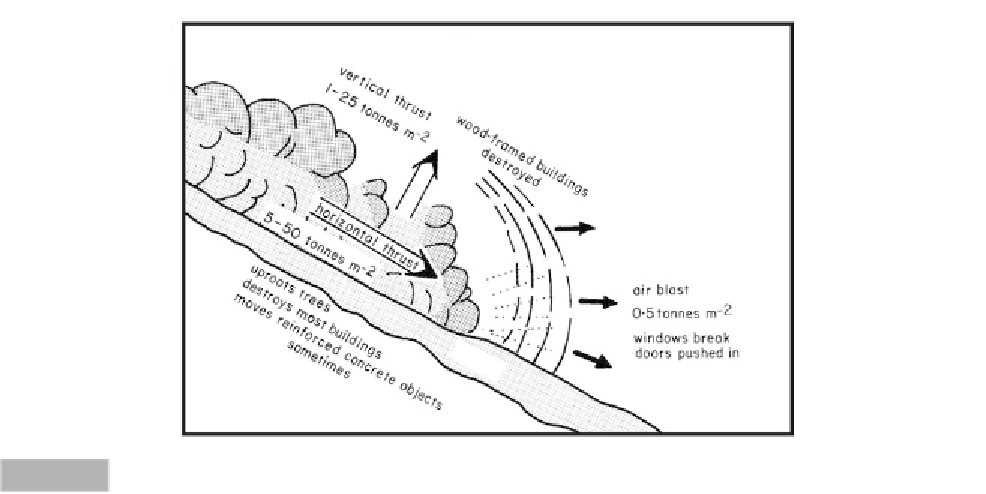Geoscience Reference
In-Depth Information
stantial erosion along part of its path. The swift
movement ensures that such flows are very powerful,
and that they are preceded by a shock wave, which for
snow avalanches may exert forces greater than
0.5 tonnes m
-2
, as shown in Figure 12.16. The internal
turbulence within a snow avalanche tends to generate
swirls of debris with velocities in excess of 300 km hr
-1
,
greater than the movement of the avalanche itself.
Forces of 5-50 tonnes m
-2
can be generated internally,
and are of sufficient magnitude to uproot trees and
move large structures.
If the debris in the flow has liquefied, and if veloci-
ties are high and the flow thin, it is possible for shear
sorting to occur internally in the flow. Shear sorting
tends to produce internal sorting of debris such that
larger objects are expelled to the top and sides of the
flow. Basal surges in volcanoes behave in this fashion,
and produce ash deposits that are well-sorted with the
coarsest material towards the top of the deposit.
The debris avalanche that wiped out Yungay in Peru in
1970 preferentially moved boulders towards the top
and sides of the flow as it underwent shear sorting;
however, it is not certain whether water or air was
involved in the sorting process. The results of shear
sorting enhance the prospect of survival for people
caught in snow avalanches. Because human bodies are
relatively large compared to the rest of the debris in
the flow, they tend to move to the top of the avalanche
under shear sorting. Rescuers simply probing the
Air-
supported flows (avalanches)
(Bolt et al., 1975; Scheidegger, 1975; Whittow, 1980;
Wolman, 2003-2004)
Avalanches are commonly thought of in terms of ice or
snow cascading down slopes; however, they are not
restricted to frozen water. Snow avalanches are part of
a phenomenon of debris movement involving the
interstitial entrapment of air. Any material may be
involved, including hot gases entrained within volcanic
tephra (as described for pyroclastic flows in Chapter
11), mixtures of sediment and water in debris
avalanches (as described in the previous section), and
collapsing loess (as occurred during the Shensi, China,
earthquake of 1556). The material in an avalanche
flow is supported by air rather than by grain-to-grain
contacts. Thus, avalanches are analogous to the lique-
faction process whereby air, rather than water, fills
voids and sustains the weight of the flow. Even if the
avalanche makes contact with the ground, or contains
a high proportion of liquid water, the internal air
content ensures that coherence is minimal, and friction
so low that the avalanche can obtain high ground veloc-
ities. Without turbulence, it is possible for velocities to
reach in excess of 1200 m s
-1
. However, avalanches
rarely exceed 300 m s
-1
because of the disruption to
movement by turbulence. Unfortunately, turbulence
permits most avalanches to entrain loose debris up to
the size of boulders, a process that can cause sub-
air blast
0.5 tonnes m
-2
windows break,
doors pushed in
Process and impact forces generated by a snow avalanche (Whittow, 1980, © and reproduced with the permission of John Whittow,
Department of Geography, University of Reading).
Fig. 12.16










